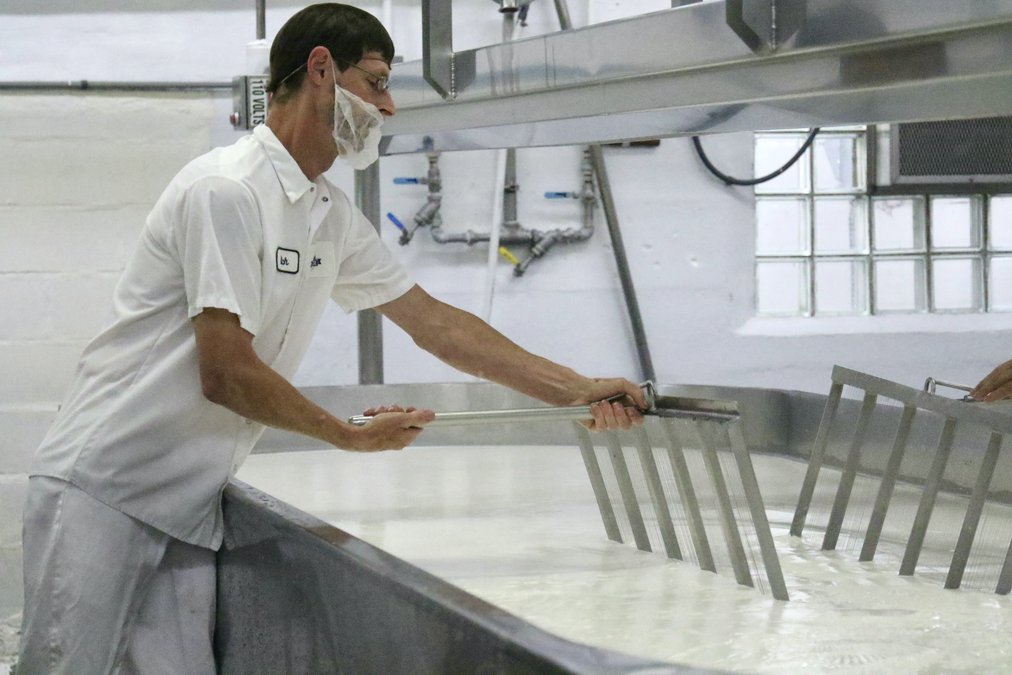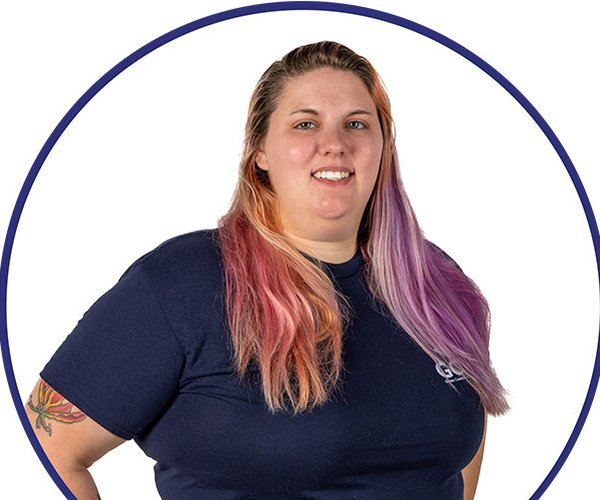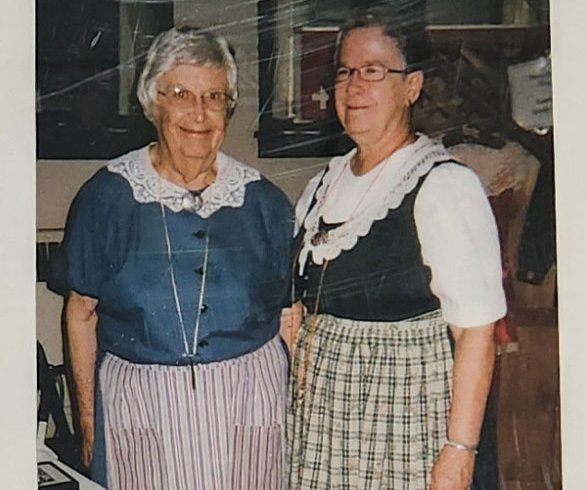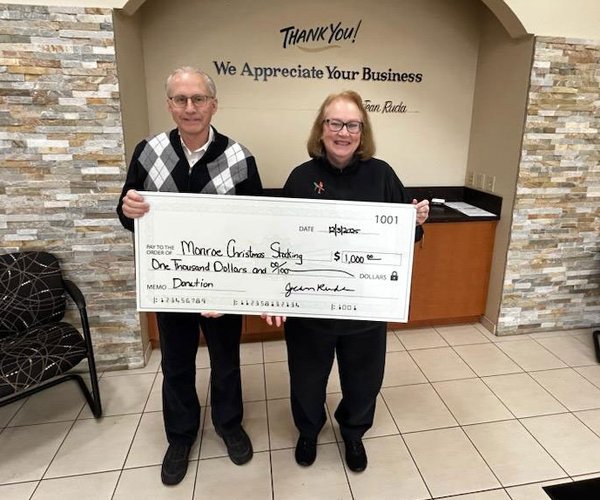By Sarah Sabatke
The Monroe Times
It’s 5 a.m. and Dan Rieder is starting his day by preparing food — for his herd of dairy cows.
He mixes feed, stirring the corn silage, haylage, high moisture shell corn and a protein mix. A kind of corn salad, if you will.
The batches are mixed every day, all produced with crops grown and stored on the farm.
Rieder estimates each cow eats about 100 pounds of feed per day. A robot delivers the food pellets to the cow’s stalls.
While it may not be what first comes to mind when we buy our favorite cheese, this is where the cheesemaking process truly begins. The food a cow eats directly affects the milk they produce, which will eventually go in to making cheese.


“The milk is all mixed together, but the Brown Swiss typically have higher butter fat,” Rieder said.
He knows his cows, the friendly ones, the grumpy ones. He also knows the young heifers that might need a bit of help learning the milking system on the farm.
The farm uses robotic milkers, allowing the cows to go in on their own, whenever they want to be milked throughout the day. On average, Rieder said the cows get milked three times a day — a collar around their necks allows the robot to automatically identify them and track when the cows have been milked, how much they are producing, and how much feed they should get while in the milker. If the cow has already been milked, it will be turned out of the machine.
Rieder’s family has operated Riedland Farms in Green County since 1929. The herd has changed over the years, starting with Holsteins and evolving predominantly to Brown Swiss cows.


From his herd of 130 cows — now 85% Brown Swiss and 15% Holstein — Rieder estimates the farm produces about 10,500 pounds of milk per day.
And, for three generations, the farm has sent that milk to Chalet Cheese Co-op.
Rieder explains that he pays for the truck that picks up their milk every day — and the milk from all farms in the co-op — and hauls it to the factory.


What is a co-op?
A co-op, or cooperative, means a facility is owned by the dairy farm members who supply milk to the facility. Chalet Cheese Cooperative, founded by five dairy farmers, continues to thrive as a partnership between the factory and participating local farmers. As part of the co-op, the farmers are the owners of the Chalet Cheese factory.


The Cheesemaking Process
There are two important words to know when talking about the start of the cheesemaking process — “culture” and “rennet.”
The recipe starts with the type of cultures that you’re adding to it. A culture is a group of bacteria that is combined specifically for the type of cheese being made. Rennet is an important ingredient to cheesemaking. Acting on the protein in milk, rennet helps to trigger coagulation (the milk turning in to a somewhat solid state, the beginning of what will become cheese).


The Cheesemaking Process
There are two important words to know when talking about the start of the cheesemaking process — “culture” and “rennet.”
The recipe starts with the type of cultures that you’re adding to it. A culture is a group of bacteria that is combined specifically for the type of cheese being made. Rennet is an important ingredient to cheesemaking. Acting on the protein in milk, rennet helps to trigger coagulation (the milk turning in to a somewhat solid state, the beginning of what will become cheese).


Robert Frie, Chalet Cheese’ operations manager, describes it like a kitchen.
“You have a recipe that you follow, you have different ingredients for different dishes that you’re going to make,” he said. For example, “if we want make something like a Gouda cheese, we’ll add different cultures to make it the right flavor profile.”


The culture is added to the milk about 10 minutes after they start to fill the vats, referred to as the maturation time. “That’s where you’re basically waking (the culture) up and going, ‘Hey, start doing your job on the milk,’” said Frie. The rennet is then added and everything is mixed through the vats so it’s evenly distributed.
The cheesemakers at Chalet Cheese multitask between four different vats, monitoring them as they each go through a different part in the process. Everything is tracked, from the cook and stir times to the maturation and cut times. Even the fat content of the incoming milk is tested and tracked, so the cheesemakers can adjust cook times as needed.
The cheesemaker will periodically test the milk to see if it has started to coagulate. Eventually, they will be able to lift up the white, gel-like mass on top, telling them it is time to cut the curd.


The cheesemakers will use cheese harps to slice and dice the curd, and the whey will start to be separated from the curd mass. The farther apart the wires on the harp, the bigger the curd size it will cut. The whey will then be pressed out of the curd mass.
“Under pressure, the cheese starts to mix together,” Frie said. “So time and temperature are important to the whole process.” The moisture content differs with each type of cheese and the higher the temperature, the more moisture you can move out of the cheese.
Limburger follows much the same process. Once the vats are mixed and processed, the milk is pumped into forms, which are flipped throughout the day. The cheesemakers will eventually use a machine to cut the forms.


While traversing the factory’s various operations spaces, Frie answered a question that is often shrouded in mystery — how does Swiss cheese get its holes? As it turns out, the answer is more scientific than someone in the back room with a cheese hole punch.
“There’s one culture where the propionic bacteria chews on the sugars that are in the cheese or the milk,” said Frie. “And then what happens is it ‘burps,’ for lack of better technical terms. If you do it right, you’ve got little fractures in the body of the cheese. That’s starting all the way in that first batch.”
After the cheese is pressed and salted, its put in a warm environment to give the cultures a space to wake up again and work on the remaining sugars in the cheese. Humidifiers keep the humidity in the room between 90 and 95%. “We control the environment so that the cheese and bacteria does what it’s supposed to do,” Frie said. The factory is also able to hold excess milk in insulated silos over the weekend.


“Then you’ll have eye formation — it usually takes about 20 to 23 days for that to happen. We monitor it closely every day. Once you’ve got some eye formations between pencil eraser size and dime size, you want to take it out of the warm room and put it in a cooler to slow down and stop that process.”
The cheese is eventually brought out of the forms, rinsed and left to dry on racks. The cheesemakers will come through and tap the cheese to see if it’s ready to go.
Frie said Chalet Cheese processes about nine to ten vats of milk a day — equivalent to about 110,000 to 120,000 pounds of milk.
“It’s a 10% yield,” said Frie. “It takes a lot of milk to make a little bit of cheese.”


Once the cheese is made, aged as much as required, and cut, it’s sent off to a local converter to form the cheese into various products, package and label the cheese. A customer could also buy cheese directly and take it to a converter themselves to convert the cheese into a certain form, re-wrap it and sell it at the consumer level.
While the back rooms are busy checking cheese progress and filling orders, cheesemakers are still busy at the milk vats, rinsing and sanitizing them so they are ready to be filled with milk again. The factory is a constant juggling act.


“Some guys are here by 1:30 a.m., 2 a.m., to make sure the vats are sanitized and ready for the day. They kind of wake the plant up,” said Frie. “Then at 4 o’clock, a majority of the other team members come in, because they’re going to start taking what was made for yesterday out of the press.”
Cheesemaker Bob Bobak is used to the early mornings, with almost 30 years in the industry. He took a part-time cheesemaking job to escape construction in the cold Wisconsin winters and never looked back.
“It’s a craft, it’s a trade for cheesemaking, and that’s one of the things that attracted me,” Bobak said. “It’s very intimate, very artisanal.” Like any intricate, multi-step process, challenges could arise unexpectedly at any stage.
“We’ve got seasonal changes in the milk,” said Frie. “If the cheesemakers aren’t on top of that, you miss it, and then you have issues.”
Though the current factory was built in 1948, Chalet Cheese has been a staple in Green County since 1885.


“(Chalet) got started because there were farms in the area that felt that they needed to have a market for their milk,” said Mike Hlubek, Chalet’s general manager. “There was a group of farmers who got together and decided they should build a cheese factory, hire a cheesemaker and pool their milk.”
Hlubek said the factory receives roughly 85,000 pounds of milk per day from their co-op farms.
“All of these farms for us are all in Green County,” he said. “That’s important for a couple reasons: one is that the milk that we get is fresh. The other important aspect of that is they’re close enough that they can come visit, they can check and see how things are going.”
One of Chalet Cheese’s sources of pride lies in their factory being the last remaining producer of Limburger Cheese in the United States. When the factory opened in 1885, Limburger was popular with immigrants — acting as a probiotic in their diet. As demand diminished, many factories transitioned to other cheeses. Chalet added cheeses like Swiss and Brick to their production, but never abandoned its Limburger roots.
“It’s not cheese that’s just produced in Green County. It literally is Green County cheese because it’s from cows that are in the same area, the milk that is from the same area,” Hlubek said. “All the things that are good about the county and the rolling hills do play a part in our cheese and the flavor of our cheese.”
Final products are sold under the Chalet Cheese, Deppeler’s and Country Castle brand names. In June, Chalet Cheese plans to start a retail cut program to produce retail sizes of cheese (i.e. wedges and smaller blocks of cheese instead of large wheels) and put the Chalet Cheese label on the final product.
“This is all an effort to try to get more funds to the farmers,” said Hlubek. “It’s all about trying to get them a better return on their investment.”


The Retail Stage
Once the cheese is made, some of the product is delivered to the Chalet Cheese Haus retail location in New Glarus.
“It is all picked up from the factory and delivered to the store by Chalet Cheese employees,” said store manager Mary Goeke. Goeke has worked with Chalet Cheese Haus since 2022.
A typical day starts with going over the daily management tasks — from making social media posts to assessing inventory and making sure the shelves are well stocked with cheeses, wines, chocolates, and other products. Before the cheese goes on to the retail shelf, it is weighed and priced.
“From there, we will get cheese samples ready for the customers,” Goeke said. “Once that is all done, we are usually ready to ‘open the doors.’”
She describes the store as quaint. “You know from the décor and the product offering that you are ‘going back in time’ and keeping traditions alive through the historical cheesemaking processes while supporting the local dairy families and local businesses mainly in the state of Wisconsin.”
Chalet Cheese Haus sells the Chalet Cheese and Deppeler’s brands, both produced by Chalet Cheese. The store also offers limited varieties of cheese from other local factories including Roelli Cheese, Friendly Goat Farms, Edelweiss Creamery and Brunkow Cheese.
The store, located at the Chalet Cheese factory, offers cheese, cheese boards and clothing, as well as larger loaves of cheese. The Chalet Cheese Haus location mainly sells ½ pound and one pound chunks of cheese.
“Offering many types of cheeses is our main focus,” said Goeke. “Customers coming to the store are looking for unique, Wisconsin-based products to take back home.”
Goeke said the store’s top sellers include their Swiss and Pannaro cheeses — the former of which has won several championship awards — as well as their award-winning Pepper Havarti cheese. And, of course, Goeke knows there is always a customer looking for Chalet’s Limburger cheese.
“The customers are looking for an ‘experience’ that ties back to the history of the cheese factory, our local dairy farmers, and the state of Wisconsin,” she said. “They love to ask about the cheesemaking process and what type of cows are on our dairy farms.”


Without milk, there is no cheese
When Dan Rieder isn’t busy on the farm, he can be found doing embryo transfer work for other farmers and coaching a baseball team. Though his schedule might be overwhelming to the average person, he claims the outside activities “keep him sane.” At the end of the day, though, he appreciates being able to raise a family on the farm.
“The kids can be outside and be active and responsible for taking care of animals and crops,” said Rieder. “They kind of learn success and failure that way and it translates into life, what actual life is.”
While passing down the skills of farm living, Rieder continues to maintain the family tradition of supplying milk to Chalet Cheese.
“It’s nice to own the factory and it’s a kind of a family tradition — you control your own destiny a little bit. It’s kind of a pride thing,” he said.
Rieder, and other farms like his, play a critical role in the intricate cheesemaking process. Without milk, there is no cheese. Bobak hopes a peek behind the curtain will give consumers a better idea of the work that goes into preparing one of Green County’s favorite foods.
“A lot of people go to buy cheese and just think, ‘Oh, it just shows up,’” said Bobak, “But they don’t know what’s going on behind the scenes or the skill and time that goes into it.”
So, next time you pick up some Wisconsin cheese at the store, know that it was made with skill and care by your neighbors — the farmers, cheesemakers, store operators and more who keep Green County’s cheesemaking industry thriving.





